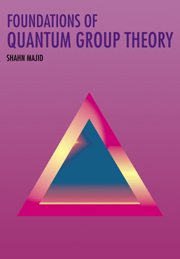Book contents
- Frontmatter
- Contents
- Introduction
- 1 Definition of Hopf algebras
- 2 Quasitriangular Hopf algebras
- 3 Quantum enveloping algebras
- 4 Matrix quantum groups
- 5 Quantum random walks and combinatorics
- 6 Bicrossproduct Hopf algebras
- 7 Quantum double and double cross products
- 8 Lie bialgebras and Poisson brackets
- 9 Representation theory
- 10 Braided groups and q-deformation
- References
- Symbols
- Index
- 2-Index
4 - Matrix quantum groups
Published online by Cambridge University Press: 14 January 2010
- Frontmatter
- Contents
- Introduction
- 1 Definition of Hopf algebras
- 2 Quasitriangular Hopf algebras
- 3 Quantum enveloping algebras
- 4 Matrix quantum groups
- 5 Quantum random walks and combinatorics
- 6 Bicrossproduct Hopf algebras
- 7 Quantum double and double cross products
- 8 Lie bialgebras and Poisson brackets
- 9 Representation theory
- 10 Braided groups and q-deformation
- References
- Symbols
- Index
- 2-Index
Summary
In this chapter, we describe another class of examples of quantum groups, quite different from the deformations of enveloping algebras in the preceding chapter. These are the matrix quantum groups, which generalise the familiar idea of defining groups as groups of matrices. They are dual to the deformed enveloping algebra quantum groups of the Chapter 3 (we will see that they are dual quasitriangular in the sense of Chapter 2.2), and as such they are dual quantum groups in the strict sense, or quantum groups of function algebra type. In other words, rather than working with the elements of the group or Lie algebra, we work with the functions on the group (see Example 1.5.2) as our classical model. When we deform a Hopf algebra of this type so that it is no longer commutative, we can nevertheless continue to think of its elements as if they were the functions on a group in this way, even though an actual underlying group no longer exists.
This point of view is a well established one in mathematics, and comes under the general heading of noncommutative geometry. We will come to this in later chapters, but, for now, we can explain the general idea at a superficial level. It is only this superficial level that is at all relevant to the present chapter, but it can nevertheless be used as a source of motivation.
This general idea of noncommutative geometry arose in the early half of this century with an important theorem of I. Gelfand and M.A. Naimark about commutative C* algebras and the related strides in algebraic geometry that were made at the time.
Information
- Type
- Chapter
- Information
- Foundations of Quantum Group Theory , pp. 108 - 177Publisher: Cambridge University PressPrint publication year: 1995
